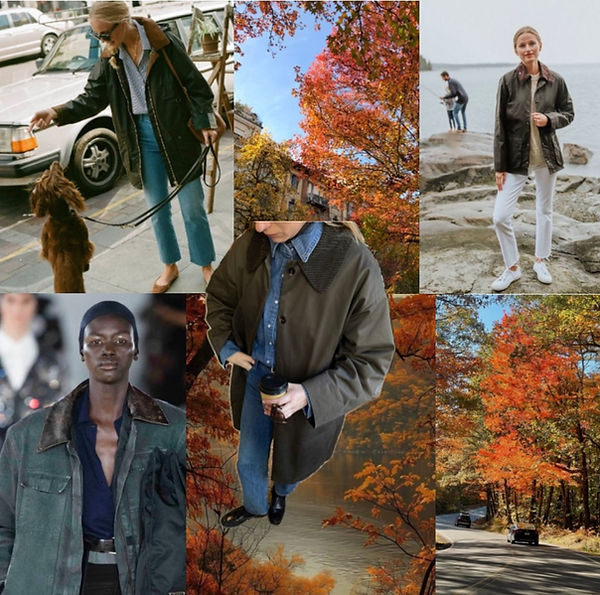Ode to the Barn Jacket- History and Style
By Elizabeth Montfort
With the resurgence of Ralph Lauren’s fashion shows and J.Crew’s iconic catalogues, one staple is especially imminent this season—barn jackets. And those of us who live between these sartorial worlds are left wondering—what exactly are we paying homage to?

The waxed, weather-beaten coat—whether it’s a Barbour or a barn jacket—has followed me throughout my life. Growing up in one of the preppiest corners of the Northeast, the Barbour was part of the unofficial uniform. Women wore theirs at farmers' markets, on misty mornings, or while walking the requisite family dog through fog-laden fields. Men, meanwhile, never left for a hunting trip without it.
The Barbour jacket, however, is distinctly British. Known for its durability and association with country living, it has become a staple among British aristocracy and royals alike. Princess Diana, in particular, brought the Barbour into the global spotlight, often seen pairing it with her effortless mix of "timeless stables" and sportier pieces. Diana’s style—an elegant blend of old-money heritage and practicality—has left an indelible mark on New England fashion. Her influence stretched across the Atlantic, blending English tradition with the American upper-class lifestyle, creating a culture that values both timeless elegance and outdoor functionality.

While the Barbour jacket remained a British institution, the barn jacket has its roots firmly planted in American soil. Originally designed as a practical coat for farmers, the barn jacket was valued for its warmth, durability, and hardiness in rural America. Over time, it evolved into a symbol of understated American elegance. By the mid-20th century, the barn jacket had become a mainstream staple, worn by those looking for a stylish, yet rugged, outer layer that reflected the American spirit.
Even as the barn jacket became synonymous with "classic Americana," its English influence is undeniable. Just as fox hunting in New England mirrors that of the United Kingdom, American fashion borrowed heavily from British traditions. With its royal and aristocratic associations, the Barbour jacket crossed the ocean and became intertwined with America’s interpretation of upper-class outdoor fashion. Today, whether you’re wearing a barn jacket or a Barbour, it’s a nod not just to the American farmer but also to a legacy of English country living, seamlessly integrated into our culture.

This season, it’s clear that the barn jacket is making a strong comeback. Since the end of August, my feeds have been filled with J.Crew and Barbour-style jackets—though many are off-brand versions. While the originals come with a heftier price tag, as someone who invested in these timeless pieces long ago, let me make the case for sticking with the classics.
I wear my Barbour jacket regularly, and as someone who believes in investing in high-quality staples that last, this could not be a more fitting example. I’ve put my Barbour through the ringer, which has never disappointed me. The beauty of these coats is that when they start to show wear, you can have them re-waxed, and honestly, they seem to fit the New England allure even better when broken in. Barbour jackets are built to last generations—it’s the kind of coat you buy once and wear everywhere until you lose it. You can even customize it with removable inserts for added warmth, or a detachable hood for rainier days. They’re incredibly versatile.
Now, I understand that Barbour jackets come with a higher price tag, and I don’t want to overlook that. There are plenty of cheaper options, however I cannot speak for the quality and longevity of those items.


